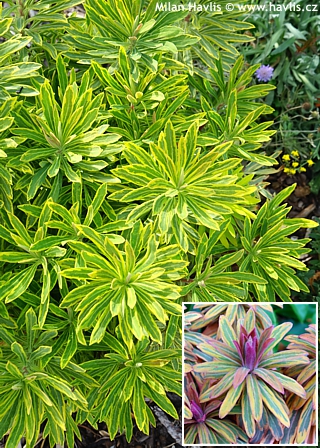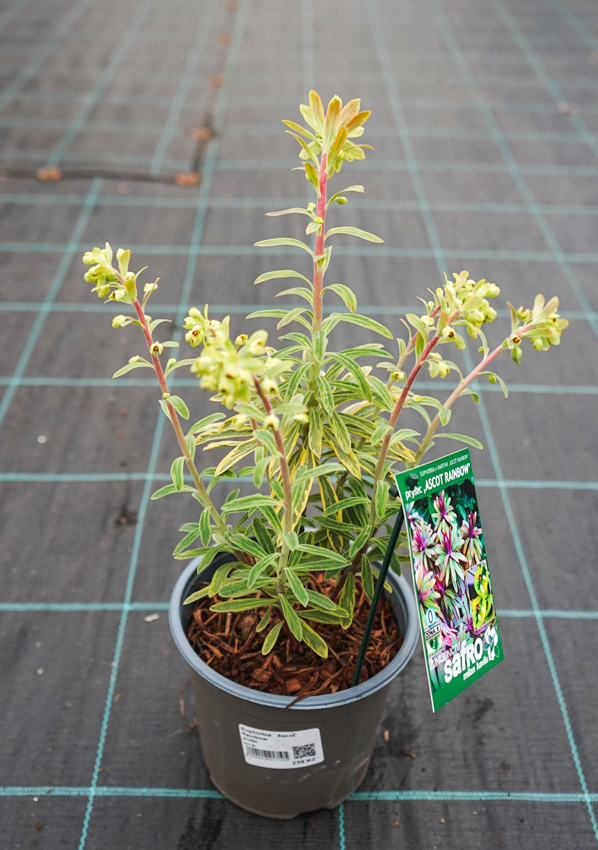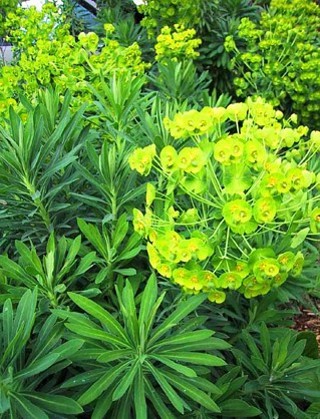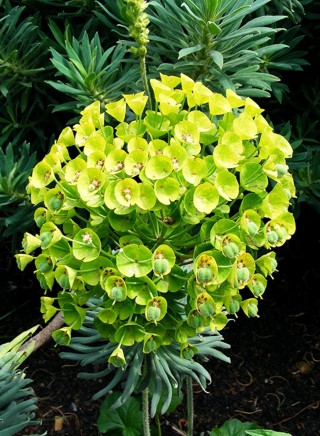Euphorbia x martinii 'ASCOT RAINBOW' spurge
Euphorbia
The genus Euphorbia belongs to the spurge family (Euphorbiaceae) and includes more than 2,100 species of herbs, shrubs, and trees, making it one of the largest genera of flowering plants in the world. Individual species can differ so much that you would hardly assign them to the same family. They occur on every continent except Antarctica, with the greatest diversity in tropical and subtropical Africa, Madagascar, and the Americas, though many species also extend into the temperate zones of Europe and Asia. The genus was first described scientifically by Carl Linnaeus in 1753 in his Species Plantarum, naming it in honour of the Greek physician Euphorbus, personal doctor to King Juba II of Numidia (52 BC–23 AD), who used certain spurges in medicine. A hallmark of all spurges is their unusual inflorescence called a cyathium – a miniature cluster of male and female flowers surrounded by showy bracts, which at first glance looks like a single bloom.
Did you know that the poinsettia (Euphorbia pulcherrima) is also a spurge? In Mexico it was already known to the Aztecs under the name Cuetlaxochitl, while they used its red bracts to dye fabrics and to treat fevers back then, today it is a symbol of Christmas around the world. Some spurges even pretend to be cacti. Take Euphorbia trigona, known as the “African milk tree”: its tall, angular, spiny stems could easily fool a layperson into thinking it was a cactus, and in Africa it was planted around homes as a living hedge to ward off evil spirits and thieves. The difference, however, is fundamental: cacti come exclusively from the Americas and their spines are modified leaves, while spurges exude milky sap and their spines are modified branches. Another curious character is Euphorbia milii, native to Madagascar. Truly, it looks like anything but a spurge. In Christian tradition it became the symbol of Christ’s crown of thorns because older plants develop densely spiny, twisted stems. And I must also mention our faithful, low‑maintenance houseplant, the Madagascar jewel (Euphorbia leuconeura), which reliably “weeds” itself by shooting ripe seeds across the room and wherever they land in soil, a new seedling soon appears.
Do you enjoy the kaleidoscope play with shapes and colours? The foliage of the Ascot Rainbow spurge behaves in much the same way, especially in autumn and winter. This garden jewel was discovered by David Glenn in Victoria, Australia, in 2005 as a spontaneous branch sport of an unnamed Euphorbia × martini plant, and he named it after his hometown. Its evergreen leaves change colour not only with the seasons but also in response to stress. In summer, they are predominantly grey-green with creamy yellow margins; in autumn, pink and purple shades appear, especially at the tips; and in winter, the whole plant turns a deep pinkish-red with rich yellow centres. This colour shift can also be triggered by drought, when the plant protectively withdraws chlorophyll into its roots, while overfertilization (especially with nitrogen) suppresses the multicoloured effect and emphasizes green tones instead.
‘Ascot Rainbow’ forms a compact, dome-shaped, slightly spreading habit with sturdy red stems, reaching up to 90 cm in height and 80 cm in width. Flowering is abundant. From spring into summer, the plant produces tubular flowers in cream, lime, green, and red, so distinctive that for one or two months they completely transform the visual character of the shrub – or rather subshrub, since these spurges are botanically known as semi-woody perennials. The cultivar is protected by patents PP21,401 (USA – 2010) and 68088 (Europe – 2011).
‘Ascot Rainbow’ combines beautifully with dark-leaved perennials such as heucheras, salvias, or sedums. In the background, it pairs well with simple evergreen shrubs like ilex, leucothoes, or pieris, while the foreground can be filled with small spring bulbs that highlight the foliage’s early-season colours. Thanks to its architecture and constant variability, it works equally well as a stand-alone specimen or as a contrasting element in a mixed border.
Euphorbia amygdaloides and its hybrids are woody perennials typical of the warmer, though not arid, regions of the Caucasus and Turkey. They tolerate high summer temperatures but require more moisture than the drought‑adapted vegetation of southern European rocks and plains. This explains their great popularity in Great Britain, where the consistently high humidity allows spurges to thrive. In our continental conditions, Galaxy Glow does best in moderately moist but well‑drained soil of any pH. It should be kept lightly moist for the first few months, but beyond that they will rarely need more water than natural rainfall provides, especially if mulched. Feeding before flowering, and again at the end of summer is beneficial, though not essential. Ascot Rainbow is reliably hardy to at least –25 °C and requires no winter protection. It is not suitable for outdoor planters, as it dislikes sudden fluctuations in temperature and moisture.
Last update: 08-12-2016; 02-10-2025
Goods are shipped all over Europe. For Russia and U.K. and for further details please read about SHIPPING OPTIONS HERE.
Are you interested in a serious discount for orders NOV-FEB? Check your options here.
THE PRICES INCLUDE VAT of 15%. For quick conversion you can use 1 CZK = approx. 0.04 EUR
- STANDARD QUALITY - Plants of this group are 1st class quality with number of branches and overall density adequate to their size and age, considering they were container grown.
- DE LUXE QUALITY - This label guarantees a luxurious quality of manually selected plants that, compared to their height and age, are exceptionally dense and beautiful.
- EXTRA - These plants are usually mature and bigger specimens with exceptional overall appearance.
- STANDARD (as described in the plant form) means a tree with a trunk of 190-210 cm and a crown at the top, unless specified differently. The commercial size for trees is their girth measured in the height of 1m from ground.
- HOBBY - These plants are of the same quality as our standard-quality plants but younger and therefore cheaper.
- SHRUB - a woody plant with branches growing bushy from the ground level.
- HALF-STANDARD or MINI-STANDARD - a small tree with shorter trunk, its size is usually specified.
- FEATHERED - These are trees with branches growing already from the base of the trunk and up along the stem.
- GRASSES and PERENNIALS - Sizes given usually read the diameter of the pot or the clump, as specified.


































.jpg)
.jpg)
.jpg)
.jpg)
.jpg)
.jpg)
.jpg)
.jpg)
.jpg)




